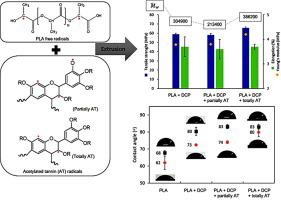Industrial Crops and Products ( IF 5.9 ) Pub Date : 2020-11-20 , DOI: 10.1016/j.indcrop.2020.113068 Jingjing Liao , Nicolas Brosse , Sandrine Hoppe , Xiaojian Zhou , Xuedong Xi , Guanben Du , Antonio Pizzi

|
A wholly bio-composite based on poly (lactic acid) (PLA) and tannin acetate was successfully prepared via in situ reactive extrusion using dicumyl peroxide (DCP) to improve interfacial adhesion. The composites based on PLA and tannin acetate with high acetylation degree exhibited increased molecular weight as compared with reactive extruded PLA, together with the improvement of Young’s modulus and tensile strength. The rheology results showed that reactive extruded PLA/tannin acetate composites exhibited increased complex viscosity and modulus storage, indicating the strong interfacial adhesion of PLA and tannin acetate. Besides, Glass transition temperature, thermal stability, and crystallinity degree were all enhanced as a result of better interaction by radical initiated polymerization. From contact angle data, free radical extruded composites had a more hydrophobic characteristic compared with PLA, which might be interesting for food packaging application. This approach opens up a pathway to diversify the applications of tannin as a component for bio-composite preparation.
中文翻译:

通过自由基引发的聚合反应改进聚乳酸/单宁乙酸酯复合材料的界面
通过使用过氧化二枯基(DCP)进行原位反应挤出以改善界面粘合性,成功制备了基于聚乳酸(PLA)和单宁乙酸盐的全生物复合材料。与反应性挤出PLA相比,具有高乙酰化度的PLA和单宁乙酸酯基复合材料表现出更高的分子量,同时杨氏模量和拉伸强度得到改善。流变学结果表明,反应性挤出的PLA /单宁乙酸酯复合物表现出增加的复数粘度和模量存储,表明PLA和单宁乙酸酯之间的强界面粘合性。此外,由于自由基引发的聚合反应更好的相互作用,玻璃化转变温度,热稳定性和结晶度都得到了提高。根据接触角数据,与PLA相比,自由基挤出的复合材料具有更疏水的特性,这对于食品包装应用可能是有趣的。这种方法开辟了一条途径,使丹宁酸作为生物复合制剂的组成成分的应用得以多样化。



























 京公网安备 11010802027423号
京公网安备 11010802027423号